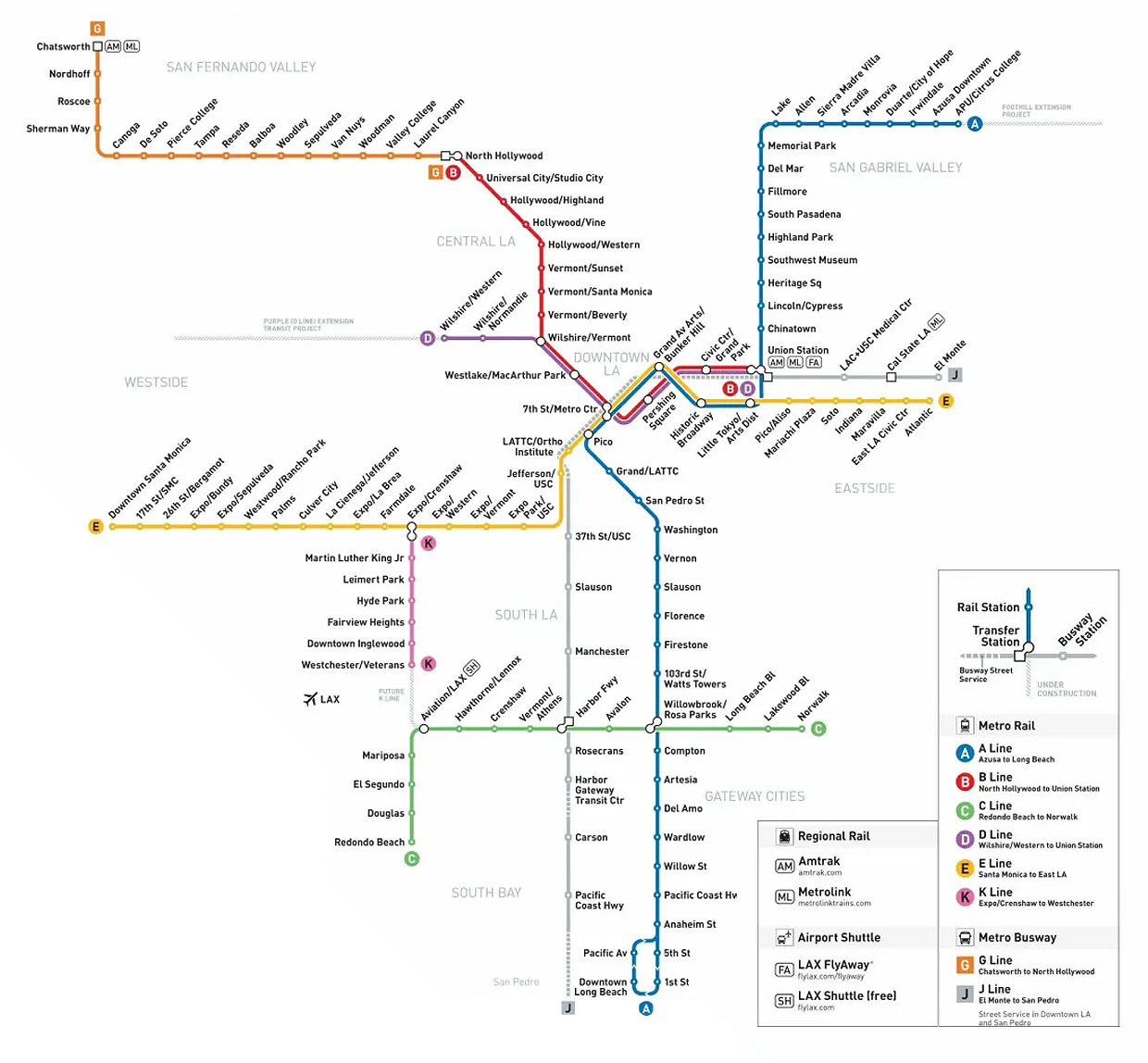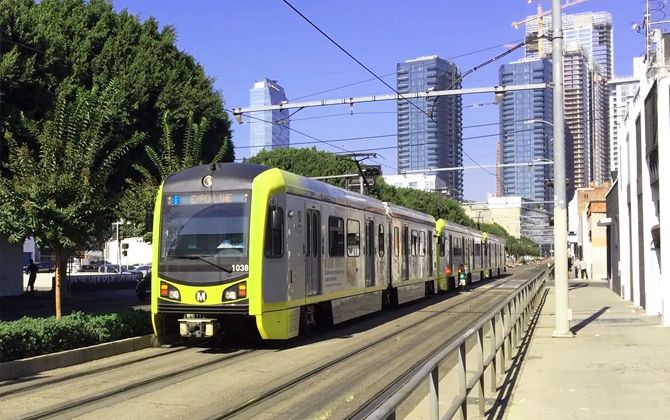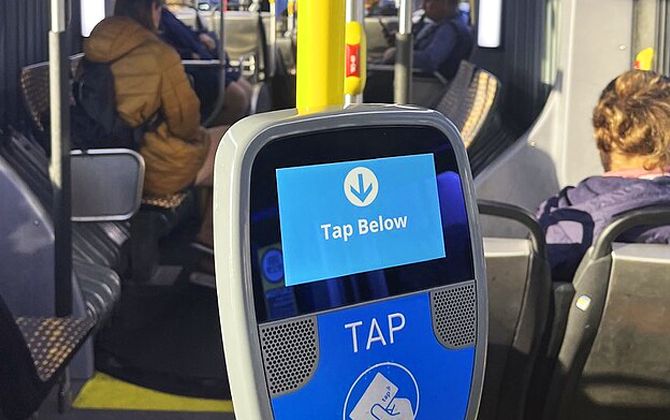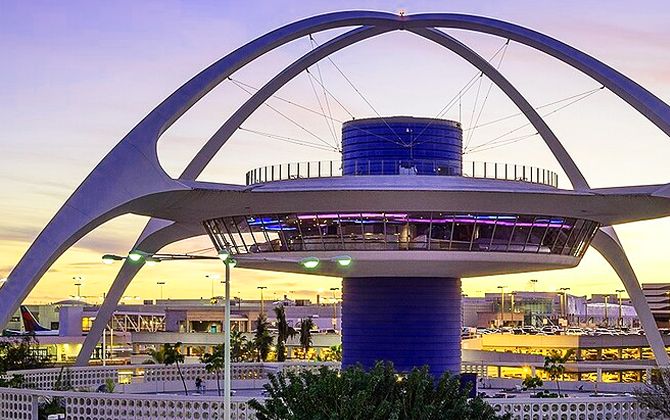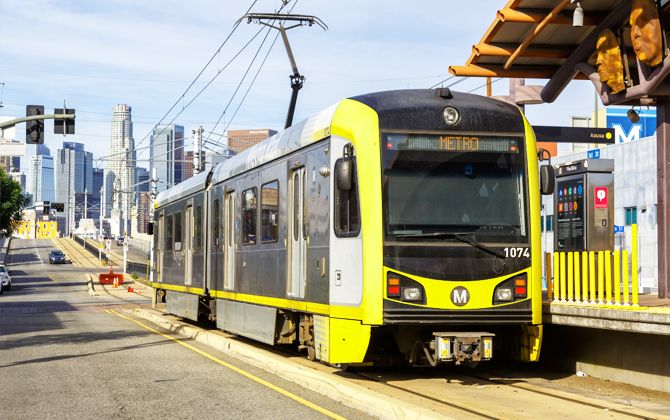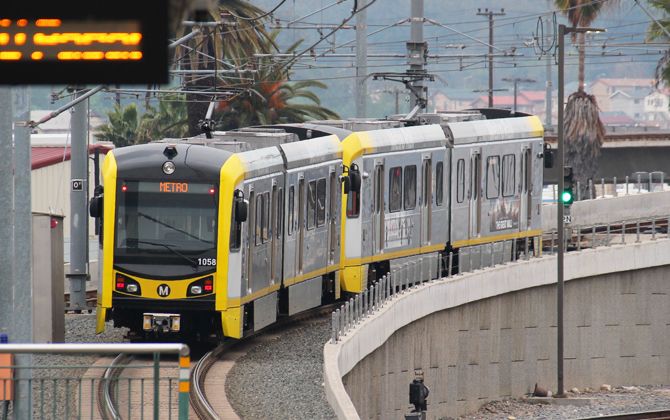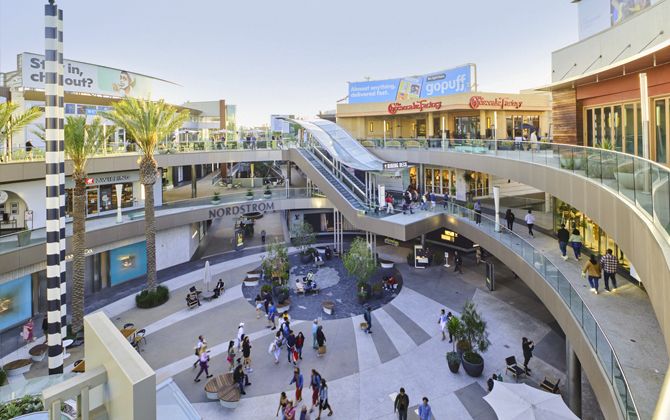The Los Angeles Metro Rail is a six-line transit system serving Los Angeles County. It combines subway and light rail, linking key neighborhoods and attractions. The first line, the Blue Line, opened in 1990. Since then, the system has expanded steadily and is now the busiest light-rail network in the United States.
As of 2024, Metro Rail carries more than 200,000 riders on weekdays, with around 68.6 million total boardings in the year. The system is owned and run by Los Angeles Metro. All stations are wheelchair accessible.
Metro Rail map of Los Angeles
Many routes follow former streetcar corridors, once used by the Pacific Electric “Red Cars” and LA Railway “Yellow Cars,” which were shut down by the 1960s.
Map of Los Angeles Metro Rail showing different lines. Click on the map to enlarge it or download the Los Angeles Metro Rail map in PDF format.
Lines and Stations
Purple Line
The Purple Line (Metro D Line) is a subway running between Koreatown and Downtown Los Angeles. It is 5.1 miles (8.2 km) long with 8 stations, from Wilshire/Western in Koreatown to Union Station in Downtown. The line follows Wilshire Boulevard and shares tracks with the Red Line east of Wilshire/Vermont.
Key stations include Wilshire/Western (terminus), Wilshire/Vermont (transfer to Red Line), 7th St/Metro Center (transfer to Blue and Expo lines), and Union Station (terminus with regional connections).
An extension is underway, adding seven new stations westward, including Wilshire/La Brea, La Cienega, Beverly Hills, Century City, and Westwood. Completion is planned between 2025 and 2028.
Blue Line
The Blue Line (Metro A Line) is a light-rail line linking Downtown Los Angeles, Long Beach, and Azusa. At 48.5 miles (78.1 km) with 44 stations, it is the longest light-rail line in the world. The northern end is APU/Citrus College in Azusa, and the southern end is Downtown Long Beach.
The route runs mostly at street level, with some elevated and underground sections. It passes through Pasadena, South Pasadena, Highland Park, Chinatown, and Downtown Los Angeles. Major stops include Sierra Madre Villa/Arcadia (Pasadena), Lincoln Heights, Chinatown, Union Station, and Willowbrook/Rosa Parks (transfer to the Green Line). The Regional Connector Tunnel links it to Flower Street and beyond.
Red Line
The Red Line (Metro B Line) is a fully underground subway stretching 14.7 miles (23.7 km) from North Hollywood in the San Fernando Valley to Union Station in Downtown Los Angeles. It has 14 stations.
Key stops include Universal City/Studio City (for Universal Studios), Hollywood/Vine (Hollywood Walk of Fame), Westlake/MacArthur Park, and 7th St/Metro Center (transfer hub). The Red and Purple lines share tracks between Wilshire/Vermont and Union Station.
Expo Line
The Expo Line (Metro E Line) runs east–west from Downtown Los Angeles to Santa Monica. It is 21.9 miles (35.2 km) long with 29 stations. The eastern end is Atlantic Station (East Los Angeles) and the western end is Downtown Santa Monica.
The line follows the former Pacific Electric route along Exposition Boulevard. Key stations include Little Tokyo/Arts District and 7th St/Metro Center in Downtown, then through Culver City, ending at Downtown Santa Monica. In Downtown it interlines with the A Line at Little Tokyo and 7th St/Metro Center.
Gold Line
The Gold Line (Metro L Line) once ran between East Los Angeles and Azusa. It was 31 miles (49.9 km) long with 26 stations, from APU/Citrus College (Azusa) to Atlantic (East LA).
In June 2023, service was discontinued as part of the Regional Connector project. The northern segment, east of Little Tokyo, became part of the A Line, while the portion from Little Tokyo to Atlantic was absorbed into the E Line.
Green Line
The Green Line (Metro C Line) runs 17.8 miles (28.6 km) from the LAX/Metro Transit Center in Westchester to Norwalk. It has 12 stations and runs entirely on a grade-separated route, much of it in the median of the I-105 freeway.
Key stops include Aviation/LAX (opened in 2024, near the SoFi Stadium area) and Willowbrook/Rosa Parks (transfer to the A Line). In June 2025, service extended to the new LAX/Metro Transit Center.
Schedule, timetables, and hours of operations
Metro Rail trains generally run from early morning until midnight.
- The Red (B) and Purple (D) Lines operate about 4:30 AM–midnight
- The Green Line (C) from around 4:00 AM–12:30 AM
- The A (Blue) and E (Expo) Lines run approximately 4:30 AM–11:45 PM
During weekday peak hours, trains arrive every 8–12 minutes. Off-peak and late-night service is usually every 15–20 minutes. Weekend and holiday schedules may differ.
Price, tickets, and cards
Metro Rail uses the TAP card, a reusable contactless fare card. The base fare for a one-way trip is $1.75. This fare includes free transfers to Metro buses and trains within two hours.
Metro offers fare capping. When paying per ride with Stored Value, you will never pay more than $5.00 in one day or $18.00 in a rolling 7-day period. After reaching the cap, additional rides are free. Traditional weekly and monthly passes have been replaced by fare capping.
Seniors (62+) and disabled riders pay a reduced base fare of $0.75. Their caps are lower as well: no more than $2.50 per day or $5.00 per week.
| Fare type | Price (USD) |
|---|---|
| Single ride (base fare) | $1.75 |
| 1-Day fare cap | $5.00 |
| 7-Day fare cap | $18.00 |
| Senior/Disabled (single ride) | $0.75 |
To ride, tap your loaded TAP card at a fare gate or validator before boarding. TAP vending machines are located at every station, and cards are also available at many retail outlets. Fares are the same across Metro buses, trains, and Busway lines. Transfers within two hours are free.
In some areas, such as the Long Beach Transit Mall, riders must tap again when reboarding. The recommended payment method is Stored Value (cash balance) on a TAP card. Always tap when transferring.
How To Ride The Metro Rail Train In Los Angeles Video!
Rail connections
Metro Rail integrates with other transit services across Los Angeles. At Union Station, the terminus of the Red (B) and Purple (D) Lines, passengers can transfer to all Metro Rail lines, Metro Bus routes, Metrolink commuter trains, Amtrak, and the Union Station FlyAway airport bus.
In Downtown Los Angeles, 7th Street/Metro Center connects all four light-rail lines with the Silver Line (J busway) at street-level stops on Flower Street. The Grand Av Arts/Bunker Hill station (B and D Lines) also links to the Silver Line. In South Los Angeles, Willowbrook/Rosa Parks station connects the Green Line (C) with the Blue Line (A) and the Orange Line (G busway) at a shared platform.
Most Metro Rail stations are also served by one or more Metro Local or Rapid buses. For example, Union Station has dozens of bus lines at its transit center. These connections extend service into neighborhoods beyond the rail network.
Connection to the airport
Los Angeles International Airport (LAX): In June 2025, Metro opened the new LAX/Metro Transit Center station on Aviation Boulevard near 96th Street. It connects the C (Green) and K (Crenshaw) Lines to LAX. A free shuttle bus runs every 10 minutes between the station and all airport terminals. In early 2026, the LAX Automated People Mover will begin service, providing a direct link into the airport. Before this, the Green Line only offered a limited shuttle.
Hollywood Burbank (BUR) Airport: Metro Rail does not serve Burbank Airport directly. Passengers can use Metrolink trains to Burbank Airport station, or connect via Metro Bus 501/167 from North Hollywood Red Line station. The free BurbankBus shuttle also links the airport with the Red Line at North Hollywood.
Other airports: Metro Rail does not directly serve Ontario or Long Beach airports. To reach Long Beach Airport, riders can take the A Line to Downtown Long Beach and continue by local bus or taxi. John Wayne Airport in Orange County is accessible via Metrolink or shuttle services. Metro’s focus has been on LAX, though Measure M includes funding for studying future airport connections.
Rules in LA Metro Rail
- Animals are not allowed on the metro unless they are in cages or are guide dogs.
- Bicycles, skates and other non-fuel powered small wheeled vehicles are allowed on the Metro. Bicycles longer than two metres and fuel-powered bicycles are not permitted.
- Vehicles may be parked in car parks but must not exceed the allotted parking time.
- Photography is permitted for non-commercial purposes.
- Proof of payment may be requested at random.
- Large pushchairs are not permitted and smaller pushchairs should be folded.
- Eating, smoking and drinking alcohol is only permitted in designated areas.
Future expansions
Metro is expanding its rail network to reach more communities. The Purple Line (D Line) Extension is moving west along Wilshire Boulevard. Phase 1 (Wilshire/La Brea, Wilshire/Fairfax, Wilshire/La Cienega) is expected to open in late 2025. Phase 2 (Beverly Dr, Century City) is set for 2027. Phases 3 and 4 will extend service to Westwood/VA Hospital and eventually Santa Monica, though no date is set.
The Foothill Gold Line, part of the Metro A Line, is also extending east from Azusa toward San Bernardino. Phase 1, with four new stations (Glendora, San Dimas, La Verne/Fairplex, and Pomona–North), opens September 19, 2025, adding 12.3 miles (19.8 km). Two more stations, Claremont and Montclair, are planned by 2030. When complete, the A Line will stretch 58 miles (93 km) end-to-end, making it one of the longest light-rail lines in the world.
Other planned projects include further D Line extensions to Santa Monica and new corridors like the Vermont Transit Corridor (planned as Bus Rapid Transit or light rail along Vermont Avenue). These depend on funding and are part of Metro’s long-term growth plans.
History
Los Angeles once had one of the world’s largest rail systems. From the late 1800s until the 1960s, the Pacific Electric “Red Cars” and Los Angeles Railway “Yellow Cars” covered the region. After their removal, Los Angeles had no rail service from 1963 until Metro Rail opened in 1990. The Blue Line (now A Line) began service on July 14, 1990.
Expansion followed through the 1990s–2010s with the Red Line subway (1986–2000), Green Line (1995), Gold Line (2003–2009), and Expo Line (2012–2016). Metro reused many of the old rail corridors while adding new tunnels and tracks. In 2020, Metro rebranded the system with letters and colors (e.g., Purple Line became D Line). In 2023, the Regional Connector linked several lines, creating today’s A and E Lines.
Today, Metro Rail carries tens of millions of riders annually—well beyond its early forecasts.
LA Metro Rail Tips
- Use a TAP Card: Pay fares with a TAP card, which can be loaded with Stored Value (cash).
- Check Schedules: Most trains run 4–5 AM to midnight. During rush hours, trains arrive every 8–12 minutes. Late nights and weekends are less frequent. Always check official Metro schedules or apps before traveling.
- Plan Transfers: A single fare gives you two hours of free transfers between Metro buses and trains. To transfer between lines, follow station signs or underground passages with your TAP card still valid.
- Safety: Stay behind the yellow platform line until the train stops. Do not block doors. All stations and trains are accessible, with elevators and escalators available. Keep personal items secure. Carry ID in case of fare inspections.
- Etiquette: Let passengers exit before boarding. During busy times, stand near doors or aisles, not in the middle of seats. Follow posted rules (no eating, loud music, or skateboarding).
- Stay Alert: Listen for announcements and watch overhead maps for upcoming stops. Metro staff and posted maps can help if you are unsure. For attractions like Dodger Stadium or Griffith Observatory, plan for an extra short bus or shuttle ride from the nearest rail station.
Fun Facts
Longest Light Rail: Metro’s A Line (formerly Blue Line) runs 48.5 miles (78.1 km) with 44 stations, making it the longest single light-rail line in the world.
Busiest Light Rail: Metro Rail is the busiest light-rail system in the U.S. In 2024, it carried about 68.6 million riders—more than double San Francisco’s Muni Metro.
Subway System: The B and D Lines (Red and Purple) are fully underground. Trains run entirely below ground, except for the short stretch between Westlake/MacArthur Park and Koreatown.
Hollywood Highlight: Hollywood/Highland Station puts you right at the Hollywood Walk of Fame, TCL Chinese Theatre, and Dolby Theatre, home of the Academy Awards.
Cultural Corridors: The former Gold Line route (now A and E Lines) runs through historic neighborhoods like Little Tokyo, Chinatown, Pasadena, and East L.A.
Green Line Fast Track: The Green (C) Line trains reach speeds up to 65 mph (105 km/h). A 19.5-mile (31.4 km) trip from Willowbrook to Norwalk takes only 34 minutes.
Accessibility: All Metro Rail vehicles are wheelchair accessible. Many stations feature public art, wide platforms, and modern safety features.
Nearby attractions
Metro Rail connects to many of Los Angeles’s top attractions:
- Exposition Park/USC Station (E Line): California Science Center, Natural History Museum, Memorial Coliseum, Rose Garden, California African American Museum.
- Jefferson/USC Station (E Line): USC campus, Shrine Auditorium.
- Downtown Santa Monica Station (E Line): Santa Monica Place mall, Santa Monica Pier, Palisades Park.
- Hollywood/Highland Station (B Line): Hollywood Walk of Fame, TCL Chinese Theatre, Dolby Theatre, Madame Tussauds.
- Universal/Studio City Station (B Line): Shuttle to Universal Studios Hollywood.
- 7th St/Metro Center (all lines): LA Live, Crypto.com Arena, Los Angeles Convention Center.
- Union Station (B/D Lines): Olvera Street, Chinatown, The Music Center, The Broad.
- Wilshire/Western Station (D Line): Wiltern Theatre.
- Chinatown Station (A/E Lines): Pedestrian path to Dodger Stadium.
- Expo Park/USC Station (E Line): BMO Stadium (LAFC), Memorial Coliseum (LA Rams).
- Pico Station (E Line) & 7th/Metro Center: LA Live, Crypto.com Arena.
Even attractions outside the rail network are reachable with short bus connections. For example, from Metro’s Norwalk Station, riders can transfer to an OCTA bus to reach Disneyland. Overall, Metro Rail combined with bus service makes it possible to access nearly every major destination in Los Angeles.
